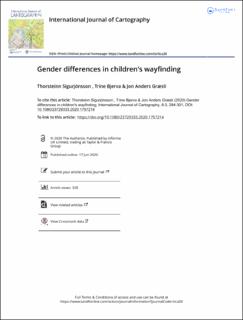| dc.contributor.author | Sigurjonsson, Thorsteinn Josef | |
| dc.contributor.author | Bjerva, Trine | |
| dc.contributor.author | Græsli, Jon Anders | |
| dc.date.accessioned | 2021-02-17T11:17:55Z | |
| dc.date.available | 2021-02-17T11:17:55Z | |
| dc.date.created | 2020-07-01T13:06:48Z | |
| dc.date.issued | 2020 | |
| dc.identifier.citation | International Journal of Cartography (IJC). 2020, 6 (3), 284-301. | en_US |
| dc.identifier.issn | 2372-9333 | |
| dc.identifier.uri | https://hdl.handle.net/11250/2728656 | |
| dc.description | © 2020 The Author(s). Published by Informa UK Limited, trading as Taylor & Francis Group
This is an Open Access article distributed under the terms of the Creative Commons Attribution-NonCommercial-NoDerivatives License (http://creativecommons.org/licenses/by-nc-nd/4.0/), which permits non-commercial re-use, distribution, and reproduction in any medium, provided the original work is properly cited, and is not altered, transformed, or built upon in any way | en_US |
| dc.description.abstract | Gender differences in spatial ability are widely acknowledged, but research to date is equivocal on gender differences in wayfinding ability of children. Indeed, the precise nature of the relationship between gender and wayfinding needs further exploration, especially within real-world outdoor environments. There is a need for more research on this topic, not least to better understand the implications of gender differences in wayfinding for facilitation of our educational programs. This article focuses on this issue by seeking to explore children's map understanding and map use in relation to gender in a large-scale outdoor environment. Ninety-seven children, 3–13 years old, were presented with a pictorial map with 7 controls which they had to locate in any order. Measure of accuracy in wayfinding (number of correctly identified controls) indicate small gender differences. However, measure of efficiency in wayfinding (time spent on the task) indicate that boys outperform girls. | en_US |
| dc.description.abstract | RÉSUMÉ:
L’impact de la différence de genre sur les capacités spatiales sont très connues, mais la recherche est aujourd’hui ambiguë sur l’impact du genre sur la capacité des enfants à se diriger. En effet, la nature précise du lien entre le genre et l’orientation n’est pas suffisamment étudiée, en particulier dans le cas de l’environnement extérieur à grande échelle. Il est nécessaire de poursuivre des recherches sur ce sujet, notamment pour mieux comprendre les implications des différences de genre sur l’orientation pour améliorer nos programmes éducatifs. Cet article se concentre sur cette question en cherchant à explorer la compréhension et l’usage de cartes par des enfants en fonction de leur sexe dans un environnement extérieur grande échelle. 97 enfants de 3 à 13 ans ont reçu une carte pictorale contenant 7 points de contrôle qu’ils devaient localiser sur le terrain dans n’importe quel ordre. Les mesures de précision dans l’orientation (le nombre de points correctement identifiés) montrent une petite différence de genre. Toutefois, les mesures d’efficacité de l’orientation (le temps passé sur une tâche) montrent que les garçons sont plus performants que les filles. | en_US |
| dc.language.iso | eng | en_US |
| dc.rights | Attribution-NonCommercial-NoDerivatives 4.0 Internasjonal | * |
| dc.rights.uri | http://creativecommons.org/licenses/by-nc-nd/4.0/deed.no | * |
| dc.subject | wayfinding | en_US |
| dc.subject | gender differences | en_US |
| dc.subject | pictorial maps | en_US |
| dc.subject | outdoor setting | en_US |
| dc.title | Gender differences in children's wayfinding | en_US |
| dc.type | Peer reviewed | en_US |
| dc.type | Journal article | en_US |
| dc.description.version | publishedVersion | en_US |
| dc.source.pagenumber | 284-301 | en_US |
| dc.source.volume | 6 | en_US |
| dc.source.journal | International Journal of Cartography (IJC) | en_US |
| dc.source.issue | 3 | en_US |
| dc.identifier.doi | 10.1080/23729333.2020.1757214 | |
| dc.identifier.cristin | 1818094 | |
| cristin.ispublished | true | |
| cristin.fulltext | original | |
| cristin.qualitycode | 1 | |

